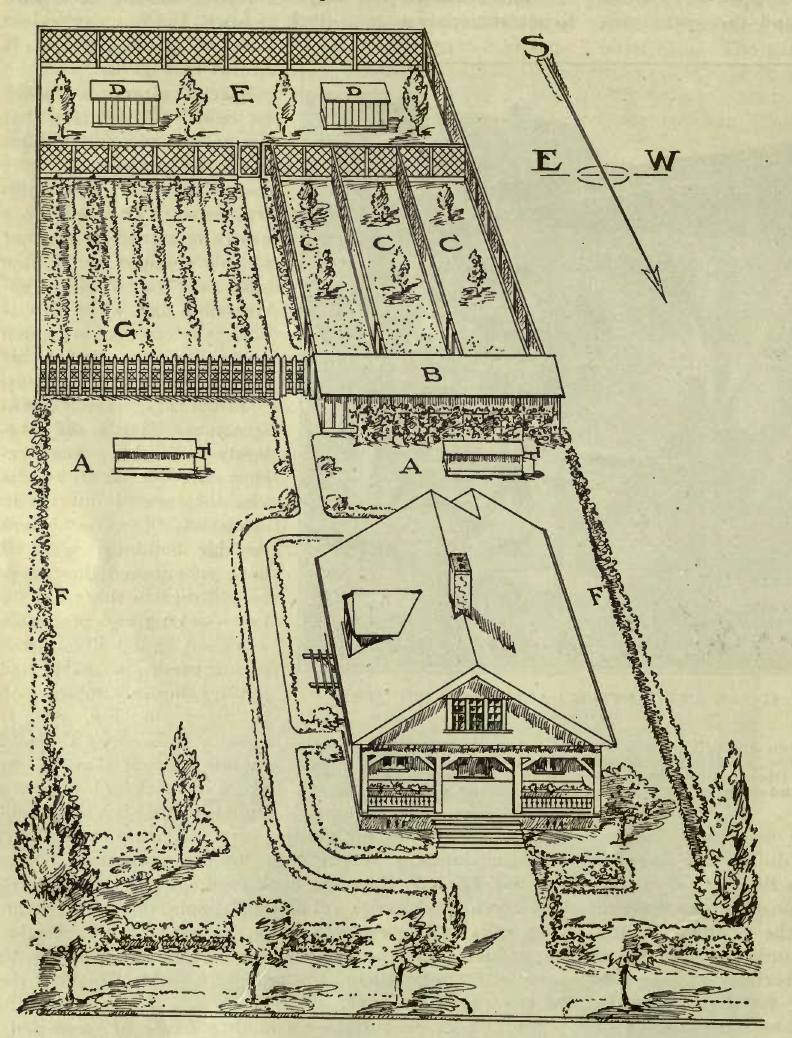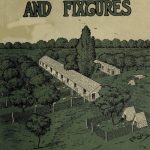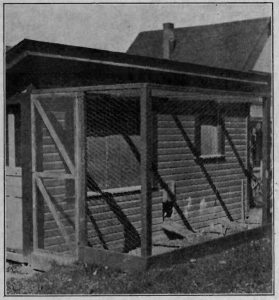
This sketch shows how to lay out a good-sized back lot where chicks are to be raised, and laying or breeding fowls kept in sufficient numbers to make them a source of income. AA are outdoor brooders; B, the laying house; C, C, C, outdoor runs for hens; D, D, colony houses; E, yard for growing stock after the young birds no longer need artificial heat; F, F, hedge on each side of the lot, affording windbreak and shade; G, the home garden.
Laying Out the Back Yard Poultry Plant
There are various ways of laying out the back yard to accommodate a small flock of fowls, but one convenient manner of doing this is shown above.
Special attention should be called to the fact that the back-yard poultry plant does not necessarily have to be an eyesore. The poultry house can be built in a neat and attractive manner at only a slight increase in cost over ramshackle construction, and when this is done the owner is much more likely to retain his interest in the work.
Temporary, inconvenient structures, hastily and carelessly built, have been responsible for poor results and for loss of interest in thousands of cases where suitable buildings would have encouraged the owner to continue in this most interesting and profitable work.
A good illustration of neatness in back-yard poultry house construction is given in the photograph below. It costs a little more to build in this manner than to put up a “shack,” but when built such a house should require no repairs for many years and without doubt it adds substantially to the value of the property.
Eggs for the Family Plus a Surplus to Sell
The plan shows how the back yard can not only be utilized for a flock large enough to supply the family table with eggs and fowls practically the year round, but also to produce a surplus for sale at good prices. This can be done without sacrificing the lawn and without making the back yard unattractive.
This plan provides for a poultry house of three pens, each of which will accommodate twenty-five fowls. The amount of yard room allowed is comparatively small, but if the yards are regularly swept and occasionally spaded, they will keep clean and free from odor and, with proper care, the fowls will do as well as on free range.
The lawn and the small, separately fenced plot in the rear will provide room for raising pullets enough to renew one-half the flock each year.
It is planned to utilize the lawn at the side and at the rear of the dwelling for brooding young chicks. If they are not kept here too long, and the brooders are moved at frequent intervals, the lawn will not be injured in any manner by such use.
When the chicks are large enough to take care of themselves, they are to be removed to the plot in the rear where small colony houses are provided for them, and where they are to run until the pullets are ready to go into the laying pens in the fall.
The cockerels can be kept here, also, until they reach broiler age when, ordinarily, they should be disposed of, the amount of ground provided being insufficient for raising large numbers of chicks to full size.As sketched above there is to be a hedge on both sides of the lawn, and the garden plot is cut off from the lawn by a neat screen, to which poultry netting can be fastened if it is desired to make it chicken-tight.
The fencing about the poultry yards, of course, will be wire netting, four to six feet high, depending upon the variety of the fowls kept.
Fruit Trees
Fruit trees should be planted in the yards, but probably will not be wanted in the garden. Flower beds can be provided to suit individual taste, and if the plan is carried out as here indicated, the fowls will not interfere in any way with having a most attractive lawn, nor will they make trouble for the neighbours.
In this plan the laying house is located at a convenient distance from the dwelling. It should be hidden by grouping shrubs in the rear, or by a grape trellis as shown.
The various features of this back-yard poultry plant are indicated by letter as follows:
- A, are outdoor brooders;
- B, the laying house;
- C, outdoor runs for hens;
- D, colony houses;
- E, yard for growing stock after the young birds no longer need artificial heat in the brooders;
- F, hedge on each side of the lot, affording windbreak and shade;
- G, the kitchen garden.
Small Back Yard Poultry Keeping
Many town and city poultry keepers do not have a lot large enough for a poultry plant of even the modest dimensions here shown, and must modify their lay-out accordingly. Some may even be reduced to the necessity of using no more space than is occupied by the house and yard illustrated in the photograph and still may find both pleasure and profit in a well-managed flock.
On the lot just referred to, no chicks at all can be raised, but a good sized laying flock is maintained by purchasing early hatched pullets in October, or by November 1st at the outside, and feeding heavily for eggs until production begins to drop off in the summer. Then the layers are killed for table use, and a new flock purchased in the fall.
The plot of ground here utilized probably is not over 12 to 15 feet square but, as here utilized, will accommodate a flock large enough to supply all the eggs that will be used by an average family and enough more to pay the cost of all feed purchased.
About this Plan
 This article is taken from Poultry Houses and Fixtures, eighth edition, published by Reliable Poultry Journal Publishing Company of Quincy, Illinois in 1919. Price $1.00
This article is taken from Poultry Houses and Fixtures, eighth edition, published by Reliable Poultry Journal Publishing Company of Quincy, Illinois in 1919. Price $1.00
It was filled with poultry house plans and layouts for small farms and back yard enterprises, many of which had been produced by universities and the US department of agriculture.
Poultry House Plans Etc.
- A-Shaped Back-Yard Poultry House Plans
- Attractive Back Yard Poultry House Design
- Chicken Coops from Recycled Packing
- Combined Portable Poultry House & Run Design
- Elevated Poultry House – Full Plans
- Locating & Setting Up Poultry Houses
- Plan for a 20 Chicken Poultry House
- Plan For One Man, Ten Acre Poultry Farm
- Plan for Poultry House for Adult Fowls or Bantams
- Practical Back Yard Mini Poultry Farm
- Practical Plan for a 10 Acre, 1,000 Hens Poultry Farm
- Preventing Drafts in Small Poultry Houses


